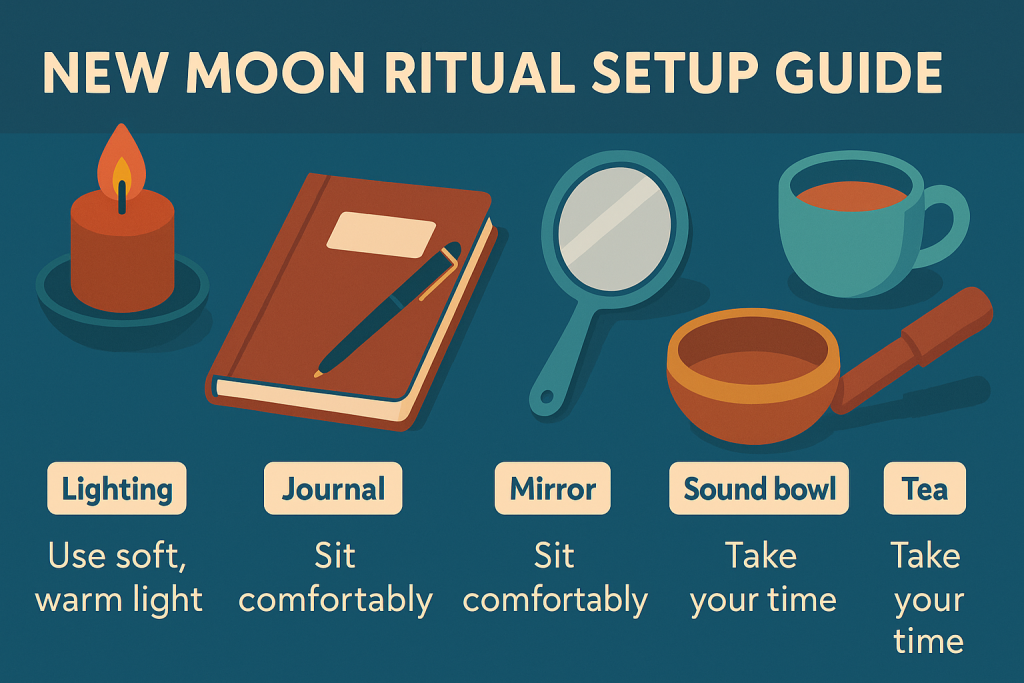5 Shadow Work Rituals to Clear Hidden Blocks Under the New Moon
We may earn a commission for purchases made using our links. Please see our disclosure to learn more.
You’re doing the work—you journal, reflect, and try to react less and respond more. But some patterns still loop: a sharp tone with someone you love, a fear that stops you from sharing your big idea, a familiar urge to people-please. That’s where Shadow Work Rituals can help. Think of them as gentle, structured moments where you meet the parts of yourself you usually avoid—then bring them into the light with compassion.
In this guide, you’ll learn five simple Shadow Work Rituals you can do under a new moon (or any fresh start) to release stuck energy and build emotional resilience. You’ll get practical steps, prompts, and tools (plus research and a few product picks) so your practice feels grounded, safe, and do-able.
Affiliate note: this article includes product recommendations that may earn a small commission at no cost to you.
What Is Shadow Work (In Plain Words)?
Shadow work is the practice of noticing and integrating the “hidden” parts of you—old wounds, protective habits, unexpressed needs, and traits you were taught to hide. It’s not about shaming yourself. It’s about shadow integration: accepting your full humanity so you can choose your actions instead of being run by autopilot.
Quick signs shadow work could help:
- You repeat the same conflict in different relationships.
- You self-sabotage right before a goal.
- You struggle with boundaries and self-love—then feel resentful later.
Why the New Moon Is a Helpful Reset (Even if You’re Skeptical)
The new moon is simply a monthly pause. Many people use it to set intentions because it naturally marks a beginning. If lunar language isn’t your thing, treat it like a monthly calendar reminder: a reset for emotional healing and honest reflection.

Prepare Your Space and Mind
A ritual is about presence, not perfection. Keep it simple:
- Time: 15–30 minutes, uninterrupted.
- Space: dim light, a comfy seat, phone on Do Not Disturb.
- Tools (optional): journal, mirror, timer, a grounding stone (see this primer on black obsidian meaning), a calm playlist.
- Intent: one sentence in your own words, e.g., “I’m curious about the part of me that fears rejection.”
Ritual #1: 10-Minute Mirror Work Check-In
This is mirror work with a shadow lens—meeting your present-moment self without judgment.
How to do it
- Sit with a small mirror at eye level. Breathe slowly for 60 seconds.
- Look into your eyes. Say your name out loud.
- Ask, “What feeling am I avoiding?”
- Speak two truths: one about a hard thing (“I feel small when I’m ignored.”) and one about your strength (“I’m learning to ask for what I need.”).
- Close with, “Even if I don’t have it all figured out, I’m willing to care for myself today.”
Ritual #2: The 3-Layer Journaling Method
Use journaling prompts in three short passes to get beneath surface stories.
Layer 1 — Facts (2–3 minutes)
- What happened? Who was there? What did you say/do?
Layer 2 — Feelings (3–4 minutes)
- Name three emotions. Where do you feel them in your body?
Layer 3 — Needs (5 minutes)
- What did you actually need? What boundary or request would honor that need next time?
Try it with a timer. Let it be messy. Your only job is to tell the truth kindly.

Ritual #3: Inner Child Letter with Self-Compassion
Inner child work bridges old pain and present care.
Steps
- Start with, “Hey little me…”
- Describe the situation your younger self struggled with (use simple language).
- Offer what wasn’t offered: “You didn’t deserve that.” “It makes sense you learned to hide.”
- Close with a gentle re-parenting promise: “I’ll protect our boundaries now.”
Optional: read the letter out loud and place your hand on your heart.
Ritual #4: Values & Boundaries Clarifier (ACT-Inspired)
When you know your values, boundaries get clearer.
Mini-exercise
- Write five values (e.g., honesty, creativity, belonging).
- For each value, list one boundary that protects it.
- Honesty → I won’t agree to plans I can’t keep.
- Honesty → I won’t agree to plans I can’t keep.
- Choose one micro-commitment for the week: a 5-minute action aligned with a value.
This is a gentle nudge toward self-awareness over self-attack.
Ritual #5: Breath + Sound Reset
Use a 4-4-6 breath (inhale 4, hold 4, exhale 6) for 3 minutes, then ring a small chime or singing bowl three times. Imagine the sound smoothing any jagged edges inside. If sound isn’t your thing, hum a single note or play a calming track.
Optional Tools to Support Your Practice
- Guided meditation (5–10 minutes) to settle your system.
- Oracle or tarot for self-reflection: a single card prompt like “What part of me needs voice?”
- Grounding objects: a soft stone, a warm cup of tea, a cozy blanket. (Ritual is about safety cues.)
Amazon Picks to Support Shadow Work (Affiliate)
These are practical helpers—none are “magic fixes.” Choose what actually supports your practice.
1) The Shadow Work Journal by Keila Shaheen (Workbook)
A popular, structured workbook with prompts for patterns, triggers, and reframes.
Features: paperback workbook; guided exercises; space for notes.
Pros: beginner-friendly; clear structure; easy nightly routine.
Cons: some readers want deeper theory.
Best for: new or returning practitioners who like step-by-step guidance.
Review snapshot: fans praise the prompt variety; critics say it can feel repetitive if you’ve used similar journals.
2) Moonology Oracle Cards by Yasmin Boland (44-card deck)
Use one card as a nightly reflection during your new moon ritual.
Features: 44 cards + guidebook; moon-phase themes.
Pros: simple prompts; lunar tie-in; beautiful art.
Cons: not a substitute for therapy; intuitive style may not suit everyone.
Best for: journaling with symbolism and seasonal rhythms.
3) Black Obsidian Palm Stone (polished)
A smooth pocket stone many people use as a tactile grounding aid while writing or breathing.
Features: approx. 2–2.5″ hand-polished; oval shape.
Pros: soothing to hold; portable; simple focus anchor.
Cons: no scientific “energy” claims—use it as a mindfulness tool.
Best for: fidgeters and sensory-grounding.
4) Ohm Store Tibetan Singing Bowl Set (3.5″)
A compact, hand-hammered bowl with striker and cushion for a gentle sound cue.
Features: ~3.5″ brass bowl; striker; cushion.
Pros: small; warm tone; helpful for breath pacing.
Cons: sound sensitivity may prefer chimes or a phone tone.
Best for: ritual open/close moments; group or solo practice.
5) Vinkor Flameless LED Pillar Candles (set with remote)
Creates low-risk ambiance for evening sessions.
Features: real-wax look; remote; timer; multiple heights.
Pros: safe; adjustable; budget-friendly.
Cons: battery use; not scented (a plus for sensitive folks).
Best for: cozy, consistent atmosphere without open flame.
Quick Comparison Table
| Model | Key Spec(s) | Warranty | Approx Price/Tier | Best For |
| The Shadow Work Journal | Guided prompts; paperback workbook | Not specified | Budget | Structured self-reflection |
| Moonology Oracle Cards | 44 cards + guidebook | Not specified | Budget | Symbolic prompts with lunar themes |
| Black Obsidian Palm Stone | ~2–2.5″ polished oval | Not specified | Budget | Tactile grounding |
| Ohm Store Singing Bowl | ~3.5″ bowl + striker + cushion | Not specified | Mid | Breath pacing & ritual tone |
| Vinkor Flameless Candles | Multi-height set + remote/timer | Not specified | Budget | Safe ritual ambiance |
Tip: choose one “anchor tool” (journal or cards) + one “soothing tool” (bowl or candle). Start small.
Research-Backed Notes: Why These Practices Help
- Expressive writing has been studied for decades. Reviews and meta-analyses show small but meaningful benefits for psychological and physical wellbeing when people write about emotional experiences for short, repeated sessions. See this accessible review of expressive writing outcomes ([Niles et al., 2013, open-access] and [Pennebaker’s overview chapter]).
- In a randomized controlled trial with healthcare workers, brief expressive-writing sessions improved symptoms related to PTSD, depression, and overall distress compared with neutral writing ([Frontiers in Psychology, 2021]).
- Mindfulness for emotion regulation: evidence suggests mindfulness-based strategies help people down-shift difficult emotions and reduce anxiety/depression partly by improving regulation skills (see a 2022 meta-analysis on induced emotions and a 2024 study on emotion-regulation mediation).
(Research is supportive but not a replacement for professional care—use these rituals alongside therapy when needed.)

Common Mistakes to Avoid
- Going too hard, too fast. Ten honest minutes beats a two-hour spiral.
- Treating tools as “fixes.” Cards, stones, bowls, and candles set a mood; you do the work.
- Skipping integration. After a session, write one sentence: “If this feeling could ask for one action, what would it be?” Then schedule a micro-action.
Trauma-Aware Safety & Ethics
- If your history includes trauma, work with a licensed therapist; shadow work can stir big emotions.
- Use the window of tolerance: if you feel flooded (numb, panicky, dissociated), stop and re-ground.
- Respect cultures when using spiritual tools. When in doubt, choose universal practices (breath, writing, values) that don’t borrow sacred items out of context.
A 7-Day New Moon Mini-Plan
- Day 1: Set your intention and do the Mirror Check-In (Ritual #1).
- Day 2: 3-Layer Journal on a recent trigger.
- Day 3: Inner Child Letter; read it aloud.
- Day 4: Values & Boundaries list; pick one micro-commitment.
- Day 5: Breath + Sound; write a 3-line insight.
- Day 6: Pull one card or re-read your journal; note any patterns.
- Day 7: Celebrate a tiny win. Rest.
FAQs
How often should I practice Shadow Work Rituals?
Once a week is plenty. During a new moon, you might do a short nightly check-in for 3–7 days. Consistency beats intensity.
Do I need to believe in astrology to benefit?
No. Use the new moon as a calendar cue for reflection and reset. The practices (writing, values, breath) work with or without lunar symbolism.
What if journaling makes me spiral?
Set a timer and use the 3-layer method to stay structured. End with one care action (tea, stretch, text a friend). If distress persists, pause and consult a therapist.
Can tarot/oracle be part of Shadow Work Rituals?
Yes—as prompts, not predictions. Ask reflective questions like, “What part of me is asking for care?” and write about the images that arise. (If cards aren’t your thing, skip them.)
How can I tell if my shadow work is starting to take effect?
Small signs: quicker repair after conflict, clearer boundaries, less people-pleasing, and a kinder inner voice. Track one area for a month.




